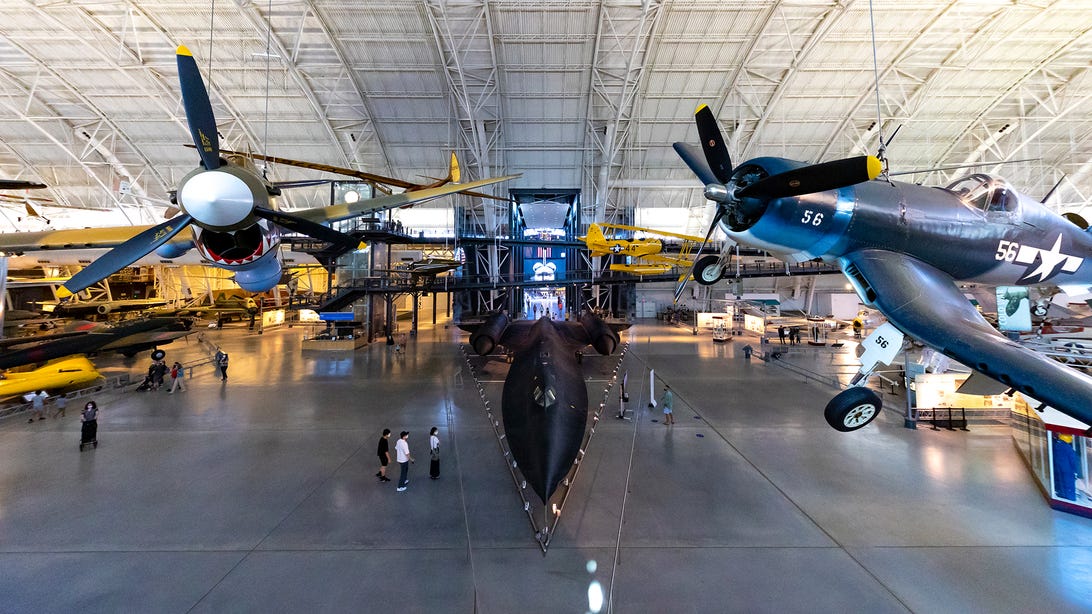
1 of 45 Geoff Morrison/CNET
Technically, the Udvar-Hazy Center is an annex to the legendary Smithsonian Air and Space Museum in Washington, DC. But this is not just a place for overflow exhibits. It’s an incredible, huge museum in its own right, housing some of the most wonderful air and spacecraft in history. Join me for a look around.
For more about this museum, and the historic planes within, check out: Soar to the skies and beyond at the Smithsonian’s Udvar-Hazy Center.

2 of 45 Geoff Morrison/CNET
In flight
It’s always a good sign when a museum takes advantage of three dimensions. Here is a hanging Vought F4U Corsair.

3 of 45 Geoff Morrison/CNET
Hangar
The majority of the collection is housed in one enormous long hangar.

4 of 45 Geoff Morrison/CNET
Oblique
Studies showed NASA’s Oblique Wing Research Aircraft had potential for impressive performance at high speed. A larger, piloted version was built as well.

5 of 45 Geoff Morrison/CNET
Not a PBY
Though at first glance this is a PBY Catalina, it’s actually a Sikorsky JRS-1. This example survived the attack on Pearl Harbor. Later that day these unarmed aircraft were sent to search for the Japanese fleet.

6 of 45 Geoff Morrison/CNET
Historic blue
This F/A-18C Hornet flew combat missions in both Iraq wars and in Afghanistan. It then flew with the Navy’s Blue Angels flight demonstration squad.

7 of 45 Geoff Morrison/CNET
Tomcat
The huge F-14 Tomcat has a timeless beauty. This specific F-14 was one of the two US aircraft involved in an air battle with Libyan MiG-23s over the Mediterranean Sea in 1989.

8 of 45 Geoff Morrison/CNET

9 of 45 Geoff Morrison/CNET
Up and (quickly) away
This aircraft was also the first ever to achieve a short take off, fly at supersonic speed, then land vertically, all in the same flight.

10 of 45 Geoff Morrison/CNET
Last Crusader
This Vought RF-8 Crusader was the last operational F-8 in the US Navy. It was in service from 1959 until 1987 and has more flight hours (7,475 to be exact, including 200 in combat) than any other F-8.

11 of 45 Geoff Morrison/CNET
Phantom
The museum’s F-4 Phantom II logged more than 5,000 hours of flight time during its 15 years of service, including 1,300 carrier landings on both the USS Independence and the USS Saratoga.

12 of 45 Geoff Morrison/CNET
Fast fish
Over 6,000 MiG-21 Fishbeds were built. Many are still in service with air forces around the world. This example’s history is a bit of a mystery. Before the museum it was on display at nearby Bolling Air Force Base in Washington, DC.

13 of 45 Geoff Morrison/CNET
Clear Sky Storm
This is the only remaining Aichi M6A Seiran, or “Clear Sky Storm.” It’s a Japanese floatplane designed for transport and launch from a submarine, ostensibly to attack the US mainland during WWII.
The YouTube channel Mustard has an excellent video about submarine aircraft carriers.

14 of 45 Geoff Morrison/CNET
Arrow
The first of three incredibly rare German aircraft at the museum is the Dornier Do 335 “Arrow”, a twin-engine heavy fighter. It was Germany’s fastest propeller aircraft of World War II, with a top speed of 474 mph. Only 37 were made before the war ended.

15 of 45 Geoff Morrison/CNET
First jet bomber
This is the only surviving Arado Ar 234, the world’s first operational jet bomber. It was largely used for reconnaissance.

16 of 45 Geoff Morrison/CNET
Rarities
The large aircraft in the middle is the only fully restored Heinkel He 219 Uhu night fighter. It was extremely advanced for its time, with radar, ejection seats and more. Fewer than 300 were made.
At the bottom is a Focke-Wulf Fw 190, which was shipped to the US after the war for study, and preserved at the museum since the late 1940s.

17 of 45 Geoff Morrison/CNET
Trimotor
This Junkers Ju 52 was built in Spain in 1951 and donated to this museum by Lufthansa.

18 of 45 Geoff Morrison/CNET
Not a toy. Seriously.
The SA-2A Sky Baby, hand-built by Ray Stits at his home in California. It actually flew at air shows in 1952.

19 of 45 Geoff Morrison/CNET
Rutan’s flyer
Burt Rutan’s Voyager is the first plane to fly around the world nonstop without refueling. It took nine days to make the trip in 1986, covering 26,366 miles, at an average speed of just 116 mph. The airframe only weighs 939 pounds when empty. And with the engines, it still weighs less than a modern Mazda Miata. It remains an amazing piece of engineering more than 35 years later.

20 of 45 Geoff Morrison/CNET

21 of 45 Geoff Morrison/CNET
Rocket Komet
The Messerschmitt Me 163 Komet was a late-war rocket-powered interceptor. It was extremely fast, at least until its very limited fuel ran out. This example is one of five brought over from Germany after World War II for testing.

22 of 45 Geoff Morrison/CNET

23 of 45 Geoff Morrison/CNET
(Highest) speed machine
The huge Pratt & Whitney J58 engines let the SR-71 cruise at Mach 3.2, or more than 2,200 mph.

24 of 45 Geoff Morrison/CNET
Burners
The engines were designed to run with afterburners always running. This was actually most efficient at Mach 3 cruise.

25 of 45 Geoff Morrison/CNET
Record setter
This specific SR-71 flew from Los Angeles to New York in 1 hour, 4 minutes, averaging 2,124 mph, a record. There’s no word on how many spooked dogs and humans were startled by the sonic boom.

26 of 45 Geoff Morrison/CNET
Black Widow and a Gekko

27 of 45 Geoff Morrison/CNET
The most famous B-29
B-29s are on display in a handful of museums, but this isn’t just any B-29.

28 of 45 Geoff Morrison/CNET
Enola Gay
This is the Enola Gay, the B-29 that dropped the atomic bomb on Hiroshima on Aug. 6, 1945.

29 of 45 Geoff Morrison/CNET
Little Boy
The Little Boy bomb created an explosion equal to 15 kilotons of TNT, and killed between 90,000 and 146,000 people.

30 of 45 Geoff Morrison/CNET
Fat Man
The Enola Gay flew as a weather reconnaissance aircraft for the second bomb drop, nicknamed Fat Man, over Nagasaki on Aug. 9.

31 of 45 Geoff Morrison/CNET
Post war
After the war, the Army Air Force flew the Enola Gay during the top-secret Operation Crossroads atomic test program, though it didn’t drop any weapons.
After sitting in various storage facilities for the next four decades, an extensive restoration project began in the mid-1980s. It took nearly 20 years to complete.

32 of 45 Geoff Morrison/CNET

33 of 45 Geoff Morrison/CNET
Dash 80
For an aircraft that revolutionized commercial air travel, the Dash 80, aka the 367-80, is remarkably small. You may know it by the name of its eventual production version, the Boeing 707.

34 of 45 Geoff Morrison/CNET
Proto 707
Even after the 707 entered service, the Dash 80 continued on for over a decade as a testbed for aircraft and engine technologies. This is, inarguably, one of the most important, or at least influential, aircraft in any museum anywhere.

35 of 45 Geoff Morrison/CNET
Foxtrot Alpha

36 of 45 Geoff Morrison/CNET
Restoration
In the museum’s restoration area they’re hard at work on a B-25, an Incom-FreiTek T-70 X-wing fighter (!) and other aircraft.

37 of 45 Geoff Morrison/CNET
Workhorse
The Space Shuttle Discovery orbiter first launched into orbit on Aug. 30, 1984. It flew 39 flights over 27 years, the most of any spacecraft.

38 of 45 Geoff Morrison/CNET
3 of 5
Discovery was the third Shuttle built, not including the atmospheric testbed Enterprise. It also was the first to be retired, being the oldest surviving Shuttle at the time.

39 of 45 Geoff Morrison/CNET
Huge
So many photos and videos of the Shuttles are from long distance that it’s hard to tell how big they really are. They’re indeed enormous, but wouldn’t look out of place, size-wise, next to most modern airliners.

40 of 45 Geoff Morrison/CNET
Main engines
The orbiter’s main engines were liquid-fueled, drawing liquid hydrogen and liquid oxygen from the big orange external tank.

41 of 45 Geoff Morrison/CNET
2 on 7
The Gemini VII capsule carried astronauts Jim Lovell and Frank Borman into orbit in 1965. It’s remarkable how small these early spacecraft were. Only 19 years separated this and the Discovery’s first flight.

42 of 45 Geoff Morrison/CNET
Endurance
The Excalibur III is a North American P-51C converted for long-distance racing. Piloted by Charles Blair, it holds several records.

43 of 45 Geoff Morrison/CNET
Spad
This is an original Spad XVI. Built in 1918 it was flown by Gen. William Mitchell, who is considered the father of the US Air Force. The B-25 Mitchell, as seen earlier in the restoration room, is named in his honor.

44 of 45 Geoff Morrison/CNET

45 of 45 Geoff Morrison/CNET


